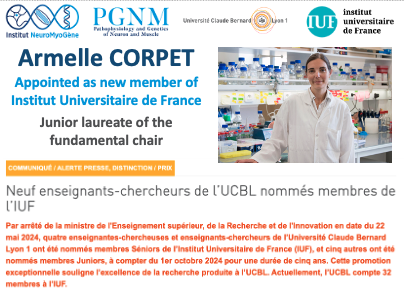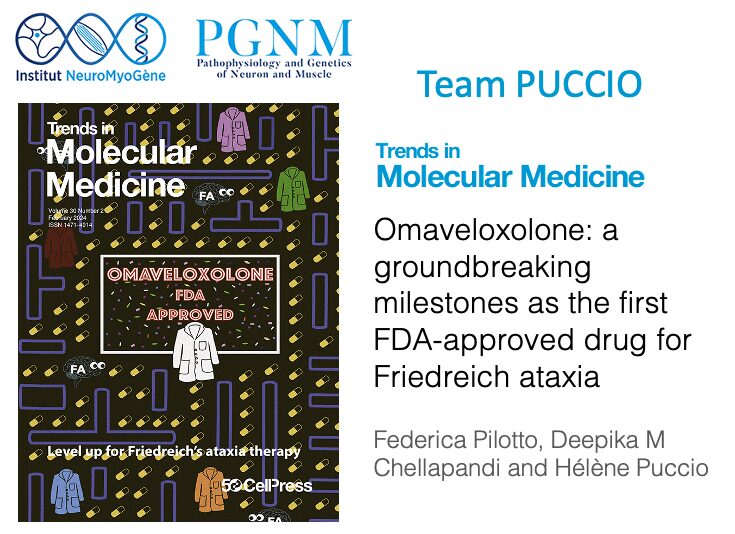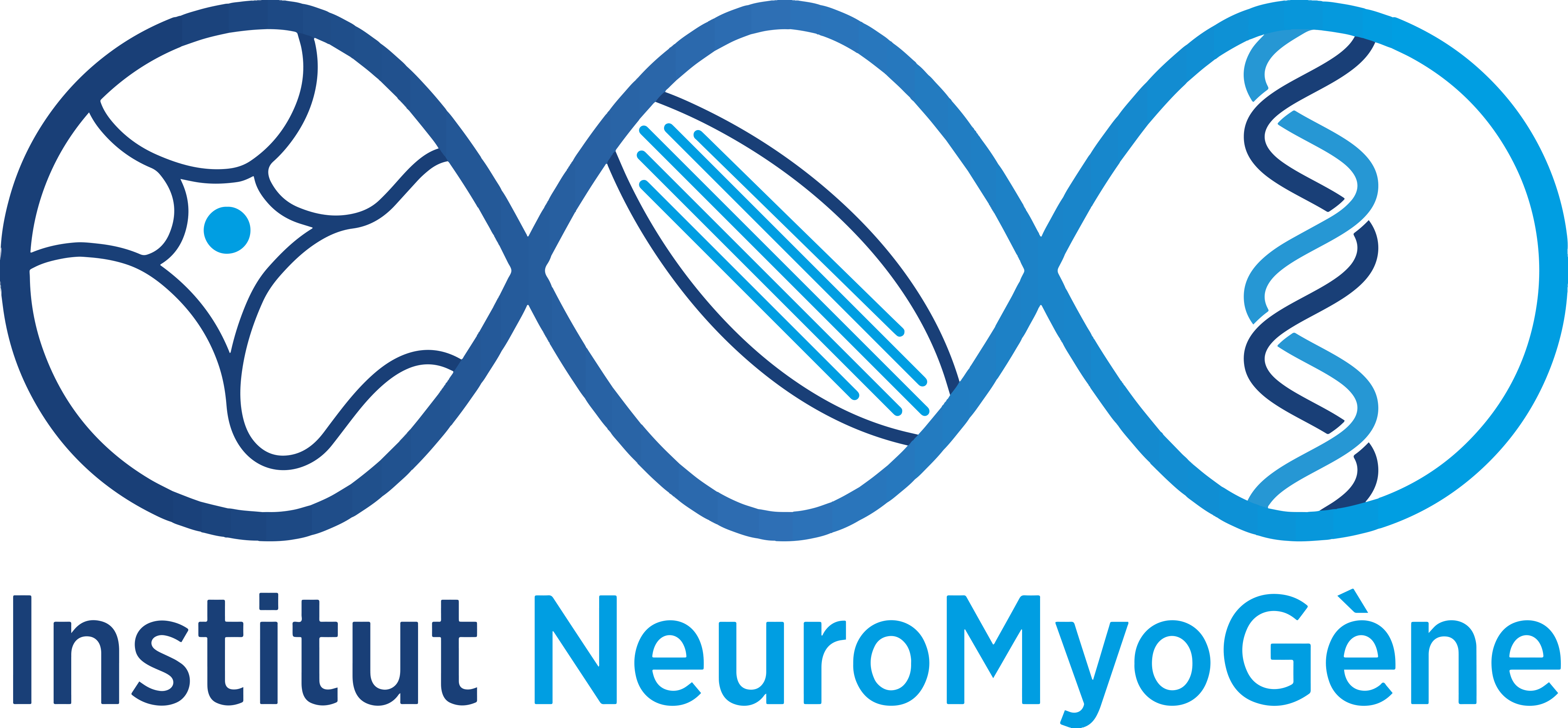Florent Bressac (team Lomonte) will defend his PhD on December 3rd at 2.00pm.
His thesis is entitled : “Dynamics of nuclear cGAS upon senescence induced by DNA damage”.
New publication for team Lomonte online on PNAS website :
Herpes simplex virus 1 (HSV-1) is a major human pathogen that remains latent in the neurons of the trigeminal ganglia of infected individuals. Its reactivation is characterised by a variety of clinical symptoms, the most serious being keratitis and herpetic encephalitis. The colonisation of the central nervous system by the virus during an individual’s lifetime is a well-known fact, but the pathophysiological effects on neuronal homeostasis are still underestimated. In an article recently published in the prestigious journal Proceedings of the National Academy of Science (PNAS), published by the US National Academy of Sciences and one of the oldest multidisciplinary journals, first published in 1914, the team led by Dr Patrick Lomonte from the Institut NeuroMyoGène – Physiopathologie et Génétique du Neurone et muscle (INMG-PGNM) CNRS UMR5261 – INSERM U1315- UCBL, showed the involvement of an epigenetic repressor complex called the Human Silencing Hub (HUSH) and its two effectors, the SETDB1 and MORC2 proteins, play an essential role in repressing the latent HSV-1 genome associated with nuclear structures called PML nuclear bodies (PML NBs). This article follows on from several other studies by the same team published over the last 12 years which demonstrate the major role of PML NBs in maintaining latent forms of the HSV-1 virus in the sensory neurons of the trigeminal ganglia and in a chromatin-silent state that allows it to escape the surveillance of the immune system. This state of dormancy, from which the virus can nevertheless escape periodically and most often asymptomatically, enables the virus to colonise the brain of infected individuals, and a growing number of studies show that there could be a link between neurodegenerative pathologies such as Alzheimer’s disease and the presence of the HSV-1 virus in the neurons of the hippocampus, the memory zone. It is therefore vital to understand the molecular mechanisms that control the latency of the HSV-1 virus and keep it in pseudo-silence, in order to develop new antiviral strategies to treat the various forms of pathology associated with infection by this virus.
S. Roubille*, T. Escure*, F. Juillard*, A. Corpet* et al., The HUSH epigenetic repressor complex silences PML nuclear body-associated HSV-1 quiescent genomes. Proc. Natl. Acad. Sci. 121 (2024). https://doi-org.insb.bib.cnrs.fr/10.1073/pnas.2412258121
AMPK control of growth, metabolism, and mitochondrial homeostasis
Reuben J. Shaw, Ph.D.
Professor, Molecular and Cell Biology Laboratory
Director, Salk NCI-Designated Cancer Center
The Salk Institute for Biological Studies, La Jolla, CA, USA 92037
Eukaryotic cells evolved a very sophisticated system to sense low cellular ATP levels via the serine/threonine kinase AMP-activated protein kinase (AMPK). Under conditions of low energy, AMPK phosphorylates specific enzymes and growth control nodes to increase ATP generation and decrease ATP consumption. In the past decade, the discovery of numerous new AMPK substrates has led to a more complete understanding of the minimal number of steps required to re-program cellular metabolism from anabolism to catabolism. This energy switch suppresses pro-growth pathways (mTORC1 and fatty acid synthesis) while inducing autophagy and lysosomal function. Recent studies have revealed that one ancestral function of AMPK is to promote mitochondrial health, via stimulation of autophagy, mitochondrial fission, and mitochondrial biogenesis. Here will present new data from our lab identifying key new steps and players in the mechanisms of AMPK controls mitochondrial homeostasis. This work has direct links to aging, metabolic disease, neurodegenerative diseases, and common forms of cancer in which this pathway is altered.
Selected publications
- Zhang, T., Xu, D., Trefts, E., Lv, M., Inuzuka, H., Song, G., Liu, M., Lu, J., Liu, J., Chu, C., Wang, M., Wang, H., Meng, H., Liu, H., Zhuang, Y., Xie, X., Dang, F., Guan, D., Men, Y., Jiang, S., Jiang, C., Dai, X., Liu, J., Wang, Z., Yan, P., Wang, J., Tu, Z., Babuta, M., Erickson, E., Hillis, A.L., Dibble, C.C., Asara, J.M., Szabo, G., Sicinski, P., Miao, J., Lee, Y.R., Pan, L., Shaw, R.J., Yuan, J., Wei, W. Metabolic orchestration of cell death by AMPK-mediated phosphorylation of RIPK1.(2023) Science. 380(6652):1372-1380. DOI: 10.1126/science.abn1725” src=”blob:https://pgnm.inmg.fr/1f1507f7-3f68-4f0c-971c-5a0a17547a51″ alt=”image003.png” width=”13.5″ border=”0″ class=”Apple-web-attachment” style=”width: 0.2812in; height: 0.2812in; opacity: 1;”>
- Kuna, R.S., Kumar, A., Wessendorf-Rodriguez, K.A., Galvez, H., Green, C.R., McGregor, G.H., Cordes, T., Shaw, R.J., Svensson, R.U., Metallo, C.M. Inter-organelle cross-talk supports acetyl-coenzyme A homeostasis and lipogenesis under metabolic stress.(2023) Science Advances. 9(18):eadf0138. DOI: 10.1126/sciadv.adf0138” src=”blob:https://pgnm.inmg.fr/1f1507f7-3f68-4f0c-971c-5a0a17547a51″ alt=”image003.png” width=”13.5″ border=”0″ class=”Apple-web-attachment” style=”width: 0.2812in; height: 0.2812in;”>
- Malik, N., Ferreira, B.I., Hollstein, P.E., Curtis, S.D., Trefts, E., Weiser Novak, S., Yu, J., Gilson, R., Hellberg, K., Fang, L., Sheridan, A., Hah, N., Shadel, G.S., Manor, U., Shaw, R.J. Induction of lysosomal and mitochondrial biogenesis by AMPK phosphorylation of FNIP1.(2023) Science. 380(6642):eabj5559. DOI: 10.1126/science.abj5559” src=”blob:https://pgnm.inmg.fr/1f1507f7-3f68-4f0c-971c-5a0a17547a51″ alt=”image003.png” width=”13.5″ border=”0″ class=”Apple-web-attachment” style=”width: 0.2812in; height: 0.2812in;”>
- Eichner, L.J., Curtis, S.D., Brun, S.N., McGuire, C.K., Gushterova, I., Baumgart, J.T., Trefts, E., Ross, D.S., Rymoff, T.J., Shaw, R.J. HDAC3 is critical in tumor development and therapeutic resistance in -mutant non-small cell lung cancer.(2023) Science Advances. 9(11):eadd3243. DOI: 10.1126/sciadv.add3243” src=”blob:https://pgnm.inmg.fr/1f1507f7-3f68-4f0c-971c-5a0a17547a51″ alt=”image003.png” width=”13.5″ border=”0″ class=”Apple-web-attachment” style=”width: 0.2812in; height: 0.2812in;”>
- Hung, C.M., Lombardo, P.S., Malik, N., Brun, S.N., Hellberg, K., Van Nostrand, J.L., Garcia, D., Baumgart, J., Diffenderfer, K., Asara, J.M., Shaw, R.J. AMPK/ULK1-mediated phosphorylation of Parkin ACT domain mediates an early step in mitophagy.(2021) Science Advances. 7(15). DOI: 10.1126/sciadv.abg4544” src=”blob:https://pgnm.inmg.fr/1f1507f7-3f68-4f0c-971c-5a0a17547a51″ alt=”image003.png” width=”13.5″ border=”0″ class=”Apple-web-attachment” style=”width: 0.2812in; height: 0.2812in;”>
Armelle Corpet, member of team Lomonte, has been appointed new member of the Institut Universitaire de France in the junior promotion 2024.
For more information, see the newsletter from the university.

Targeting Muscle Stem Cells during Aging: from Mechanisms to the Discovery & Clinical Validation of Nutritional Activators
Absract:
The regenerative capacity of skeletal muscle relies on the activity of Muscle Stem Cells (MuSCs), a population of resident stem cells that enables myofiber repair following intense exercise or injuries, and contributes to tissue homeostasis and turnover. Aging and muscle diseases impair MuSC function, leading to altered regenerative capacity and progressive loss of skeletal muscle mass and strength.
In a first project, we generated a novel StemRep dual color Pax7 and Myf5 in vivo reporter mouse model to investigate MuSC heterogeneity. High levels of Pax7 protein and low levels of Myf5 delineate a deeply quiescent MuSC subpopulation with higher asymmetric division and distinct dynamics of activation, proliferation, and commitment. Aging primarily reduces the Myf5Low MuSCs and skews the stem cell pool towards Myf5High cells with lower quiescence and self-renewal capacity. Altogether, we establish the StemRep model as a versatile tool to study MuSC heterogeneity and broaden our understanding of the function of Myf5 in regulating MuSC quiescence and self-renewal in homeostatic, regenerating, and aged muscles.
In a second project, we used a high-content imaging screen of natural molecules to identify nicotinamide (NAM) and pyridoxine (PN) as potent bioactive nutrients from vitamin B metabolism that synergistically stimulate MuSC activity, while having a history of safe human use. In human clinical cohorts or preclinical models, endogenous levels of NAM and bioactive PN decline during aging and inter-independently associate with muscle mass and walking speed. Oral treatment with a combination of NAM/PN accelerates muscle repair in vivo by stimulating MuSCs and enhances recovery of muscle strength. In a human randomized placebo-controlled clinical trial using eccentric contraction-induced muscle regeneration in healthy volunteers, oral NAM/PN supplementation was well tolerated and stimulated the myogenic activity of MuSCs detected via increased number of MyoD and Myogenin positive cells in muscle biopsies during recovery. Collectively, our results establish NAM/PN as a promising nutritional intervention that stimulates MuSCs, enhances muscle repair, and alleviates muscle decline during aging, and opens new opportunities to enhance muscle recovery and manage regenerative capacity in muscle disorders through nutrition.
Most significant recent publications:
Trigonelline is an NAD+ precursor that improves muscle function during aging and is reduced in human sarcopenia. Membrez, Migliavacca , Christen,… JT Treebak,… Koopman, Lynch G, Sorrentino V and Feige JN. Nature Metabolism, 2024, 6(3):433-447.
Apelin stimulation of the vascular skeletal muscle stem cell niche enhances endogenous repair in dystrophic mice. Le Moal E, Liu Y, Collerette-Tremblay, , …, Feige JN, Auger-Messier M, Dumont NA, Bentzinger CF. Science Transl Med., 2024 20;16(739)
The mitochondrial calcium uniporter (MCU) promotes muscle energy metabolism and mobility by regulating mitochondrial redox state. Weiser A, Hermant A, …, Sorrentino V, Feige JN & De Marchi U.
Redox Biology, 2023, 64:102759
Evidence for inefficient contraction and abnormal mitochondrial activity in sarcopenia using magnetic resonance spectroscopy. Stephenson MC, Ho, …, Feige JN, Merchant RA, Tay SKH. J Cachexia Sarcopenia Muscle. 2023, 14(3):1482-1494
An Engineered Multicellular Stem Cell Niche for the 3D Derivation of Human Myogenic Progenitors from iPSCs. Mashinchian O, De Franceschi F,… G, Dumont NA, Lutolf MP, Feige JN*, Bentzinger CF*
EMBO J, 2022, 41(14):e110655. *: co-senior author
Mitochondrial oxidative capacity and NAD+ biosynthesis are reduced in human sarcopenia across ethnicities. Migliavacca, E., Tay, S.K.H., Patel, H.P., …Karnani, N., Feige, JN. Nature Communications, 2019, 10(1), 5808
Aging Disrupts Muscle Stem Cell Function by Impairing Matricellular WISP1 Signals Secretion from Fibro-Adipogenic Progenitors. Lukjanenko L, Karaz S, Stuelsatz P, …, Rudnicki MA, Bentzinger CF, Feige JN.
Cell Stem Cell, 2019, S1934-5909(18)30604-0.
The exerkine apelin reverses age-associated sarcopenia. Vinel C, Lukjanenko L,…, Feige JN, Vellas, Valet P, Dray C. Nature Medicine 2018, 24(9):1360-1371.
Loss of Fibronectin from the Aged Stem Cell Niche Affects the Regenerative Capacity of Skeletal Muscle in Mice. Lukjanenko L, Jung MJ, Hegde N, … , von Maltzahn J, Feige JN*, Bentzinger CF*. Nature Medicine 2016, 22(8):897-905. *: co-senior author
Epigenetics Meets Immunity and Inflammation
Absract:
The function of chromatin is largely dependent of its underlying structure. Linker histone H1 is a key player in both nucleosome and chromatin fiber 3D organization. Yet, how does H1 achieve this was the major challenge that has defied the epigenetic community for decades. Here, I will initially describe at higher resolution the conformational transitions of both the nucleosome and the chromatin filament induced by the binding of histone H1 and the resulting condensed structures. Some data on the elasticity of native mitotic chromosomes will be also presented.
The DNA templated processes (gene expression, DNA repair, DNA replication, mitosis, etc.) requires unfolding of the condensed H1-bound chromatin and then refolding in order to preserve nucleus homeostasis. Histone variants are key epigenetic factors, deeply involved in chromatin dynamics. The second part of the talk will be focused on the histone variant H2A.Z. H2A.Z is an essential protein, which is implicated in the vast majority of nuclear processes. Yet , how H2A.Z exhibits such pleiotropic functions remains unclear. We have addressed this question by using mouse genetics and a large cohort of molecular and cellular biology and epigenetic approaches. Depletion of H2A.Z in the stem cells of the basal layer of the skin epidermis leads to the activation of the three main cytosolic DNA sensor pathways, namely cGAS/STING, AIM2 inflammasome, and Toll-like receptor sensors, suggesting the presence of self-DNA in the cytoplasm. We provide evidence that such DNA originates, upon depletion of H2A.Z, from the accumulation of mitotic defects, micronuclei, R-loops, stalled replication forks, de-repression of distinct DNA repeats and structurally altered mitochondria. These changes instigate a profound innate immune response, leading to the activation of the interferon-responsive genes and a strong inflammation phenotype. Our data identify H2A.Z as a major epigenetic mediator of genome integrity, and its deficiency affects overall genome organization and nuclear homeostasis.
During the last years, our lab was very much interested in the etiology of epigenetic and rare diseases. At the end of the talk, some of our data on both Rett syndrome, a very severe neurodevelopmental disease, and Rahman syndrome, a newly identified rare disease casually linked with mutations in the linker histone H1, will be also presented.
Relevent Publications:
1. Graies, M. et al., submitted
2. Nucleosome dyad determines the H1 C-terminus collapse on distinct DNA arms – Louro, J.A. et al., Structure 2023, Feb 2;31(2):201-212
3. MeCP2 is a microsatellite binding protein that protects CA repeats from nucleosome invasion – Ibrahim A. et al., Science 2021, Jun 25;372(6549) :eabd5581.
4. Structure of an H1-Bound 6-Nucleosome Array Reveals an Untwisted Two-Start Chromatin Fiber Conformation – Garcia-Saez I. et al., Mol. Cell, 2018 Dec 6;72(5):902-915.e7.
5. Structure and Dynamics of a 197 bp Nucleosome in complex with Linker Histone H1 – Bednar J. et al. , Mol Cell. 2017, May 4;66(3):384-397.e8.
6. Molecular basis and specificity of H2A.Z-H2B recognition and deposition by the histone chaperone YL1 – Latrick, CM et. al. Nat Struct Mol Biol. 2016 Apr;23(4):309-16.
7. ANP32E is a histone chaperone that removes H2A.Z from chromatin – Obri, A. et al. Nature. 2014 Jan 30;505(7485):648-53

New publication team Puccio
Trends Mol Med 2024 : doi 10.1016/j.molmed.2023.12.002
Highlights
Omaveloxolone represents the first FDA-approved drug for Friedreich’s ataxia (FA).
Omaveloxolone targets nuclear factor erythroid 2-related factor 2 (NRF2), which is a master regulator in the antioxidant pathway.
The omaveloxolone clinical trial serves as an example for future design of clinical trials.
A resolutive cure for FA would probably be achieved only via combinatorial therapy.
New publication – Schaeffer’s team
NAR 2024 : doi.org/10.1093/nar/gkae020affiche-TV-EN-BE-NAR-2024

